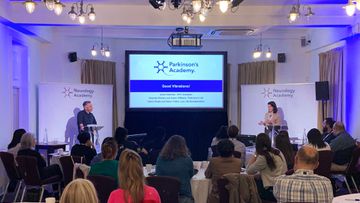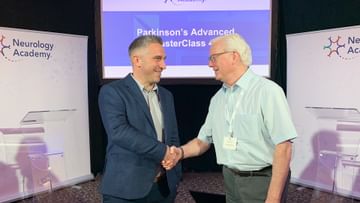Assessing fracture risk in the PD clinic
by Dr Greg Waddell
StR 7 in Geriatric and Internal Medicine, NHS Lanarkshire
Within the local data collected for the UK Parkinson's Audit 2015, our team reported that "evidence of fracture risk / osteoporosis considered in the last year" was missing from nearly all our sampled case notes. Despite recognising that those attending our Parkinson's disease clinic were at an increased risk of fractures¹ - hip fractures in particular² - the absence of an agreed approach to fracture risk assessment in our population was likely to result in missed opportunities to avoid harm.
The current Parkinson's guidelines (NICE, SIGN, AAN) give no meaningful instruction on what assessment is appropriate, and when it should be applied. In the absence of specific national guidance, regional centres have published their own pragmatic approach to fracture risk assessment in Parkinson's disease population.³
However, the SIGN guideline on the 'Management of osteoporosis and the prevention of fragility fractures', updated in March 2015, comes the closest yet to explicit guidance for our patient group.4 It suggests that fracture risk assessment: may be considered in those over 50 years, with Parkinson's disease, particularly in the presence of other factors; and should be made in the context of previous fragility fractures. It also strongly favours the QFracture tool, and shifts away from empirical treatment with bisphosphonates - with a lower threshold for employing DEXA.
A quality improvement project was conceived to introduce elements of this guideline into the Parkinson's disease clinic. Iteratively, through recurrent Plan-Do-Study-Act cycles, we reduced some of the barriers to reliably conducting a basic fracture risk assessment efficiently in the outpatient setting. The interim report generated for the Parkinson's Academy, demonstrated that in those in whom we had made an estimation of fracture risk - almost half met the SIGN threshold for consideration of DEXA. Half of this group had previously undergone assessment or were already on appropriate therapy; one declined onward referral; and two gentlemen agreed to attend for DEXA. The importance of having a systematic approach to applying these guidelines was evidenced by the fact that neither of the gentlemen highlighted for investigation were phenotypically frail, recurrently falling nor did they have a history of previous fracture.
The current improvement aims of the project are focussed on elements of process: exploring methods of recording and communicating when assessments have been made; what elements should be delegated to primary care; how do we ensure assessments are repeated; how should risk be communicated to patients. As with all quality improvement projects, this project relies on making small, thoughtful changes to a process, examining the effects of change regularly, and using successes to embed good practice.
References
- Pouwels S, Bazelier MT, de Boer A, Weber WEJ, Neef C, Cooper C, et al. Risk of fracture in patients with Parkinson’s disease. Osteoporos Int 2013;24(8):2283-90.
- Chen YY, Cheng PY, Wu SL, Lai CH. Parkinson’s disease and risk of hip fracture: an 8-year follow-up study in Taiwan. Parkinsonism Relat Disord 2012;18(5):506-9. 68.
- Lyell V, Henderson E, Devine M, Gregson C. Assessment and management of fracture risk in patients with Parkinson’s disease. Age Ageing (2015) 44 (1): 34-41.
- Scottish Intercollegiate Guideline Network. Management of osteoporosis and the prevention of fragility fractures. Edinburgh: SIGN; 2015. (SIGN Guideline No. 142)
Related articles
'The things you can't get from the books'
Parkinson's Academy, our original and longest running Academy, houses 23 years of inspirational projects, resources, and evidence for improving outcomes for people with Parkinson's. The Academy has a truly collegiate feel and prides itself on delivering 'the things you can't get from books' - a practical learning model which inspires all Neurology Academy courses.


